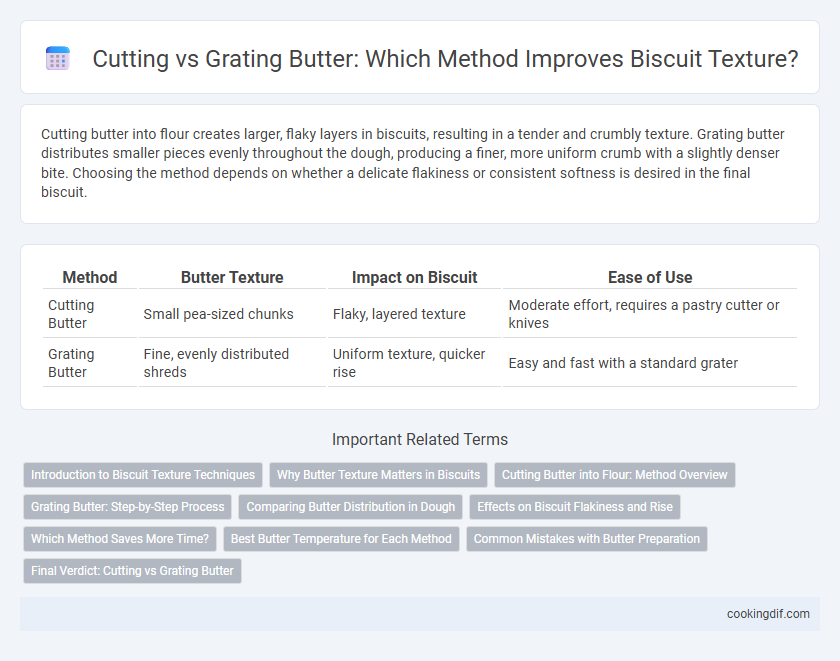Cutting butter into flour creates larger, flaky layers in biscuits, resulting in a tender and crumbly texture. Grating butter distributes smaller pieces evenly throughout the dough, producing a finer, more uniform crumb with a slightly denser bite. Choosing the method depends on whether a delicate flakiness or consistent softness is desired in the final biscuit.
Table of Comparison
| Method | Butter Texture | Impact on Biscuit | Ease of Use |
|---|---|---|---|
| Cutting Butter | Small pea-sized chunks | Flaky, layered texture | Moderate effort, requires a pastry cutter or knives |
| Grating Butter | Fine, evenly distributed shreds | Uniform texture, quicker rise | Easy and fast with a standard grater |
Introduction to Biscuit Texture Techniques
Cutting butter into flour creates distinct, flaky layers essential for classic biscuit texture, while grating butter allows for quicker incorporation, resulting in a tender crumb. The size and temperature of butter pieces influence the final rise and flakiness of biscuits. Mastering the balance between these techniques enhances the biscuit's lightness and mouthfeel.
Why Butter Texture Matters in Biscuits
Butter texture significantly impacts biscuit flakiness and tenderness by controlling how fat layers distribute within the dough. Cutting butter into small chunks creates distinct pockets of fat that melt during baking, producing a light, flaky crumb structure. Grated butter, with its finer texture, blends more evenly, resulting in a denser, softer biscuit by reducing large air pockets.
Cutting Butter into Flour: Method Overview
Cutting butter into flour involves using a pastry cutter or two knives to break the cold butter into small, pea-sized pieces evenly distributed throughout the flour, which creates a flaky texture in biscuits. This method ensures that the butter remains solid, allowing it to melt during baking and form steam pockets that contribute to a light, tender crumb. Grating butter instead results in thinner, more uniformly sized pieces, which can produce a denser texture but cuts down preparation time.
Grating Butter: Step-by-Step Process
Grating butter into biscuit dough ensures an even distribution that creates a flaky, tender texture by allowing small pockets of butter to melt during baking. To grate butter effectively, first chill it until firm, then use a coarse grater to shred it directly over the flour mixture. This method maintains the butter's cold temperature and prevents overworking the dough, resulting in perfect biscuit layers.
Comparing Butter Distribution in Dough
Cutting butter into dough creates larger, uneven pieces that result in a flaky, layered biscuit texture by melting and forming steam pockets during baking. Grating butter produces finer, more uniformly distributed butter strands that blend smoothly into the flour, yielding a tender, crumbly biscuit with less distinct layers. The choice between cutting and grating butter directly impacts the biscuit's crumb structure and overall mouthfeel due to differences in butter particle size and distribution.
Effects on Biscuit Flakiness and Rise
Cutting butter into biscuit dough creates small, uniform flakes of fat that melt during baking, producing a tender, flaky texture and optimal rise. Grating butter results in thinner, more evenly distributed pieces that blend quickly with the flour, leading to a finer crumb but slightly reduced flakiness and lift. The choice between cutting and grating butter affects the biscuit's crumb structure, with cutting favored for pronounced flakiness and grating preferred for delicate tenderness.
Which Method Saves More Time?
Grating butter saves more time compared to cutting, as it immediately produces fine, evenly sized pieces that blend quickly into flour, accelerating dough preparation. Cutting butter into cubes or chunks requires more effort and precise handling to achieve a consistent texture, often prolonging the mixing process. Using grated butter ensures faster incorporation, leading to a quicker biscuit-making workflow.
Best Butter Temperature for Each Method
Cutting butter into flour works best when the butter is cold, around 40degF (4degC), to create a flaky, crumbly texture by preventing the fat from fully melting into the dough. Grating butter requires slightly softer butter at approximately 50degF (10degC), which allows it to shred smoothly and evenly, distributing small, uniform pieces that melt quickly, enhancing tenderness. Maintaining the proper butter temperature optimizes the biscuit's texture, balancing flakiness and softness.
Common Mistakes with Butter Preparation
Cutting butter into small cubes before mixing ensures even distribution and prevents overworking the dough, which can cause toughness in biscuits. Grating butter directly into the flour creates finer particles that promote flakier layers but can lead to excessive melting if not chilled properly. A common mistake is using room temperature butter when cutting or grating, as this reduces the desired texture and compromises the biscuit's rise and flakiness.
Final Verdict: Cutting vs Grating Butter
Cutting butter into small pieces creates uneven pockets of fat in biscuits, producing a flakier texture, while grating butter results in finer, more uniformly distributed fat, yielding a tender crumb. Professional bakers often prefer cutting butter for traditional flaky layers, whereas grating suits quicker biscuit recipes with a softer consistency. The final verdict depends on desired texture: cut butter enhances flakiness, grated butter promotes tenderness in biscuits.
Cutting butter vs grating butter for texture Infographic

 cookingdif.com
cookingdif.com